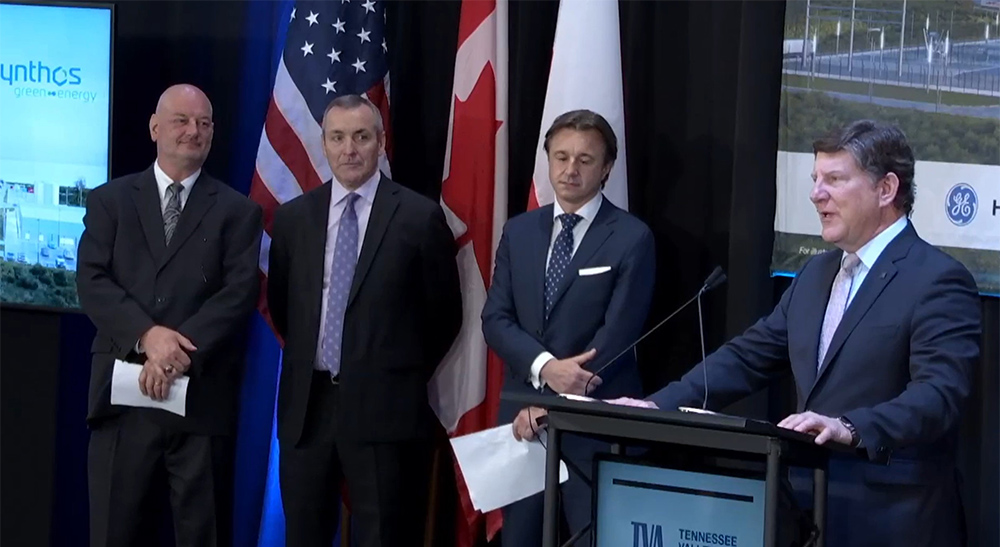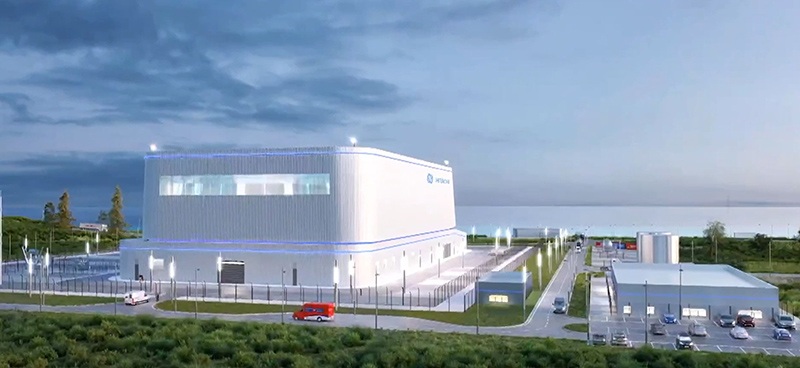
The Tennessee Valley Authority last week struck a multinational agreement on small modular reactor development with GE Hitachi Nuclear Energy, Ontario Power Generation and Synthos Green Energy, a Poland-based wind and nuclear generation developer.
Under the partnership, the companies will develop and invest in a standard design for the GE-Hitachi BWRX-300 small modular reactor (SMR) that they hope will be licensed and deployed in the U.S., Canada, Poland and other countries. GE Hitachi expects the companies to invest $400 million in the SMR’s development.
“It’s a great collaboration that spans three countries. … This is just the beginning, the foundation,” GE Hitachi Nuclear Energy CEO Jay Wileman said during a March 23 press conference in D.C. “This is really the launch of a platform going forward to help solve climate change.”
Wileman said nuclear energy will inevitably become part of the equation to reach net-zero carbon emissions by midcentury.
“Nuclear has to have a seat at the table, but we’ve got to earn that seat at the table,” he said. “To do that, we’ve got to be on-schedule, on-budget, and it’s got to be a competitive cost.”
He said the BWRX-300 SMR’s common design will allow it to be replicated at varied sites.
“I hope in 10, 20 years from now, people look back on this day and it will have aged well,” TVA CEO Jeff Lyash said. “What you should see here is partnership between a great technology company and three great industrial companies in the power sector.”
Lyash said energy security and decarbonization are challenges that the U.S., Canada, Poland and every other country in the world must face. “You cannot sacrifice one for the other,” he said.
“Nuclear is one of the critical solutions” to reach a secure, decarbonized energy future, Lyash said.
 From left: GE Hitachi CEO Jay Wileman, Ontario Power Generation CEO Ken Hartwick, Synthos Green Energy CEO Rafal Kasprow and TVA CEO Jeff Lyash | TVA and GE Hitachi
From left: GE Hitachi CEO Jay Wileman, Ontario Power Generation CEO Ken Hartwick, Synthos Green Energy CEO Rafal Kasprow and TVA CEO Jeff Lyash | TVA and GE Hitachi
TVA announced last year that it will build a BWRX-300 SMR by 2032 at the Clinch River Nuclear site near Oak Ridge, Tenn. The federal agency received a voucher from the Department of Energy’s Gateway for Accelerated Innovation in Nuclear to study future sites for advanced nuclear reactors. (See TVA Defends Rates, CO2 Reduction Plans in House Inquiry; TVA Receives Federal Assist on Future Nuclear Plans.)
Its Board of Directors in 2021 approved a nearly $200 million investment for a New Nuclear Program that will examine advanced reactor technology options for future deployment at Clinch River and other potential sites.
 Artist’s rendering of a GE Hitachi small modular reactor | GE Hitachi
Artist’s rendering of a GE Hitachi small modular reactor | GE HitachiTVA holds the country’s only early-site permit from the Nuclear Regulatory Commission. The federal utility has said it could seek licensing for Clinch River as early as this year.
Lyash says the utility’s goal is to demonstrate that it can build a fleet of SMRs in its footprint. TVA hopes to help design the next generation of reactors that will be ready to deploy in the 2040s, he said.
It plans to preserve and extend the operational life of its existing nuclear fleet, exemplified by last year’s replacement of the steam generators at Watts Bar Nuclear Plant Unit 2.
Ontario Power Generation also plans to install a BWRX-300 SMR as early as 2028 at its existing Darlington Nuclear Generating Station site on Lake Ontario. The project broke ground three months ago.
“We have a technology, we’ve got a project, we’ve got a plan to deliver new, clean electricity to our grid before the end of this decade,” Ontario Minister of Energy Todd Smith said, adding that the process began with more than 100 potential designs.
Synthos’ Orlen project aims to install 10 GW of capacity with dozens of small modular reactors across Poland between 2029 and 2036. The first 10 sites will use the BWRX-300 SMR technology.
Ontario Power Generation CEO Ken Hartwick said he hopes the partnership will inspire confidence to develop SMRs in other countries.
“I think this has been a long time coming,” he said. “This is what it’s going to take to succeed with a nuclear build. It’s going to be strong partnerships; it’s going to be stakeholder engagement and a lot of hard work, but we will succeed.”
Kathryn Huff, assistant secretary for the U.S. Office of Nuclear Energy, called the partnership a “model” for cutting-edge private investment efforts.
“It takes a lot of dollars to make real change happen, and the federal government can’t provide all of those dollars,” she said. “Our one dollar needs to turn into trillions of dollars on the private side, and this group of individuals is doing just that. This partnership is precisely what will result in commercial liftoff for small modular reactors, which the [Department of Energy] is really excited about as a technology. … We love a public-private partnership, but a private-private-private-private partnership is even better.”
Huff said to meet climate goals, the world will need to double or possibly triple its current nuclear capacity by 2050. She said the partnership’s companies are proving it’s “implementation season.”
Poland’s ambassador to the U.S., Marek Magierowski, said that while he was trying to shy away from bold statements, he said he believed “nuclear is the future.”
“I believe this is something we can all agree on, you as producers of energy and us, the consumers,” he said. “If we want to breathe cleaner air, if we wish to satisfy our society’s ever-growing energy needs, if we want to survive global economic turbulence, we need to put more chips in on nuclear.”
Magierowski admitted that acronyms are not his forte and said he initially thought the BWRX-300 SMR sounded like a cute robot from “Star Wars.”
“I’m confident that Poland, the U.S. and Canada will become even closer to each other through such deals. As close as Luke Skywalker, Han Solo, R2-D2 and BWRX-300,” he said, jokingly.

